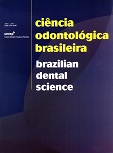Presença de fungos na dentina humana: implicações arqueológicas e forenses
DOI:
https://doi.org/10.14295/bds.2004.v7i3.447Abstract
Quando se encontram remanescentes humanos, algumas questões sobre a identificação são levantadas e uma das primeiras diz respeito à antiguidade do material. A distinção entre amostras recentes e arqueológicas pode ser feita pela identificação ou não de fungos na dentina humana através da técnica histoquímica do PAS (periodic acid Schiff). Para validar esta técnica, avaliamos três amostras diferentes. A primeira composta de dentes de um indivíduo com datação de 2640 anos antes da data presente. A segunda composta de dentes com idades de 69, 67, 48 e 36 anos. A terceira refere-se a dois dentes extraídos recentemente. Na amostra mais antiga observou-se a presença de inúmeras estruturas filamentosas compatíveis com hifas de fungos no interior dos túbulos dentinários. Estes resultados apontam a presença dessas estruturas na dentina como um indicativo de que o material não tem origem recente. A técnica utilizada é um recurso de baixo custo e rápidos resultados para uma primeira classificação e distinção dos remanescentes humanos.
Downloads
Downloads
Published
How to Cite
Issue
Section
License
Brazilian Dental Science uses the Creative Commons (CC-BY 4.0) license, thus preserving the integrity of articles in an open access environment. The journal allows the author to retain publishing rights without restrictions.
=================




























